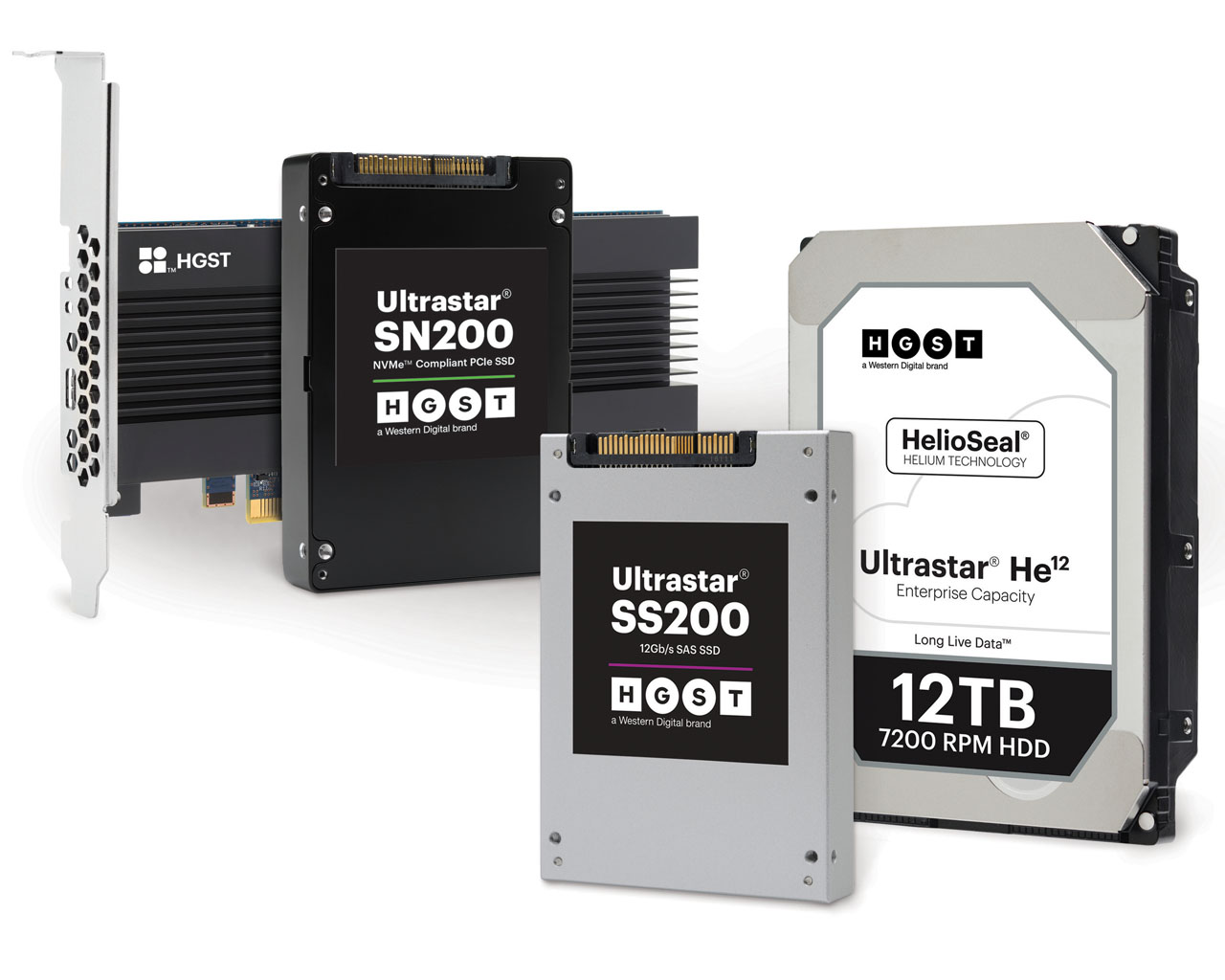WD Offers 12TB HDD and 8TB SSDs Today, Promises QLC SSDs In The Future
Western Digital (WD) held its investor day to cover its post-acquisition strategic maneuverings after its $19 billion SanDisk purchase. The storage world is quickly moving to flash for performance applications, such as PC desktops and notebooks, and in the data center, 15K HDDs are already under duress, and 10K HDDs aren't far behind. However, flash vendors aren't going to stop at just assaulting the performance-based segment. New promising innovations, such as QLC SSDs, will see SSDs attack the high capacity HDD market, as well.
The world is transitioning from disk to flash, and WD's purchase of SanDisk was a wise move. WD had already built up quite a stable of flash technology on the enterprise side through a number of acquisitions that it placed under its HGST subsidiary. The company had some SSD product overlaps prior to the SanDisk acquisition (such as Virident and STEC SSDs), but now there are even more areas that the company will eventually have to whittle down to one product line.
SanDisk brought along a flash industry-leading patent portfolio (5,000+). The two companies combined have over 14,000 patents, so there are plenty of directions to explore.
WD's move to attack the world of flash is well-timed, particularly as SanDisk is co-developing new technology that will allow SSDs to assault high-capacity HDDs. At the Flash Memory Summit, Toshiba already announced that it's pursuing QLC SSDs, which store four bits of data per cell and will enable much higher density and lower cost. WD also benefits from the fruits of SanDisk's partnership with Toshiba in the joint Flash Forward initiative. SanDisk and Toshiba have jointly manufactured NAND since 2010, and because Toshiba has announced its intentions to produce hefty QLC SSDs, we assumed that WD would also have a hand in the new technology, as well.
At its analyst's day, WD confirmed that it is also working on QLC SSDs. We can expect to see ultra-high capacity SSDs in the future; Toshiba plans to offer 100TB models, although WD hasn't provided a specific launch date or capacities. QLC SSDs will bring significant challenges on the endurance front, but for bulk data storage they will be hard to beat, and pricing should be attractive. We've done some basic math and come to the conclusion that QLC SSDs are feasible for client use, such as in desktop PCs, at 4TB+ of capacity.
For the most part, the two product lines and IP portfolios are rather complementary, so WD will extract plenty of value from SanDisk (which it purchased at fire-sale pricing). As expected, WD announced several new items from its HGST subsidiary, but it didn't introduce any new SanDisk products, which will likely take some time as the two companies complete the integration process. The company will also be able to combine its HGST and WD product lines when the MOFCOM restrictions expire in October 2017.
HGST Ultrastar 12TB HDD
HGST's Ultrastar He12 HDDs use speedy PMR (Perpendicular Magnetic Recording) technology in tandem with eight platters to provide a beefy 12TB of capacity. The 7,200-RPM HDD provides solid performance measurements of 243 MiB/s of sustained sequential performance and 390/186 read/write IOPS at QD32. The helium-infused HelioSeal design allows the drive to scale to eight platters and provides a 2.5 million hour MTBF.
Get Tom's Hardware's best news and in-depth reviews, straight to your inbox.
The drive comes in both 6GB/s SATA and 12Gb/s SAS flavors, and it offers many of the same features we observe in the current class of market-leading 10TB HDDs that we recently tested. The hits don't stop at 12TB; the company also has a 14TB SMR (Shingled Magnetic Recording) HDD on its immediate roadmap. WD noted at its analyst day that it is working with HAMR (Heat-Assisted Magnetic Recording), which uses miniature lasers to increase recording density. HGST also reported that it has now shipped more than 12 million helium HDDs.
Ultrastar 8TB SN200 SSDs
The Ultrastar SN200 SSDs are the next-generation models of the award-winning NVMe HGST SN150 we recently tested. The new models offer up to 8TB of capacity in both 2.5" (SN200) and Add-In Card (SN260) form factors. The larger AIC model leads the way with up to 6.1/2.2 GB/s of sequential read/write throughput and 1,200,000/200,000 random 4K read/write IOPS.
The 2.5" model brings up to 3.3/2.1GB/s of sequential throughput and 830,000/200,000 read/write IOPS. The lower performance in the smaller model is likely due to the thermal constraints involved; it's hard to dissipate as much heat from the denser package. Both SSDs are available with either 1 or 3 DWPD (Drive Writes Per Day) of endurance, and performance is slower with the less-endurant models (as expected). The SN200 comes with an industry standard five-year warranty and a two million-hour MTBF.
Ultrastar SS200 12Gb/s SAS SSD
SAS SSDs continue to be a growing segment even in the face of the speedy NVMe challengers, largely due to their fault-tolerant dual-ported connection. Dual-ported NVMe SSDs are still early in the technology cycle, so SAS SSDs will continue to thrive for the foreseeable future. The SS200 comes in a multitude of capacities that span from 400GB up to 7.68TB in the 2.5" form factor. HGST split the drives up into 1 and 3 DWPD classes. Although the 3DWPD may not seem as impressive as some of the 10 and 15 DWPD SSDs we've seen in the past, we must account for the increased capacity, which equates to (up to) 24TB of endurance per day--more than enough for taxing workloads.
The SS200 provides up to 1.8/1 GB/s of sequential read/write throughput, and up to 250,000/86,000 random read/write IOPS for the 3 DWPD model. The SAS models come equipped with a higher 2.5 million-hour MTBF and a five-year warranty.

Paul Alcorn is the Editor-in-Chief for Tom's Hardware US. He also writes news and reviews on CPUs, storage, and enterprise hardware.



